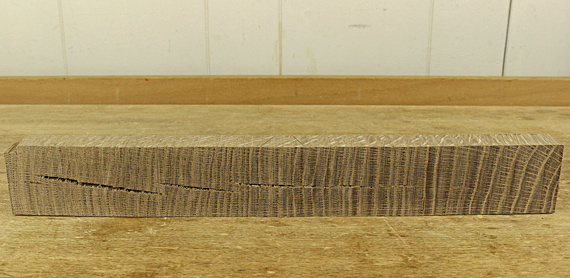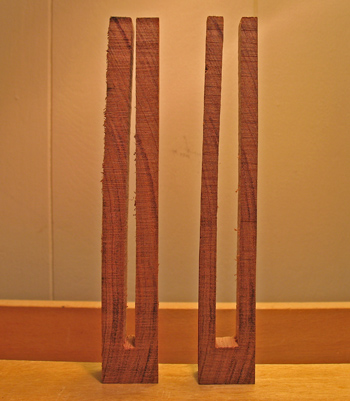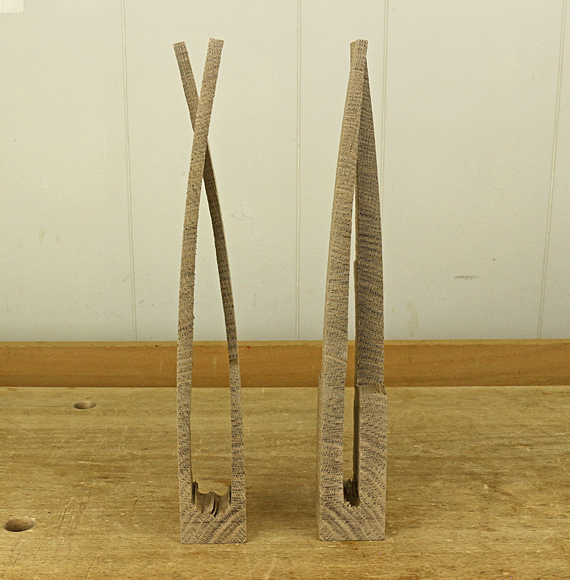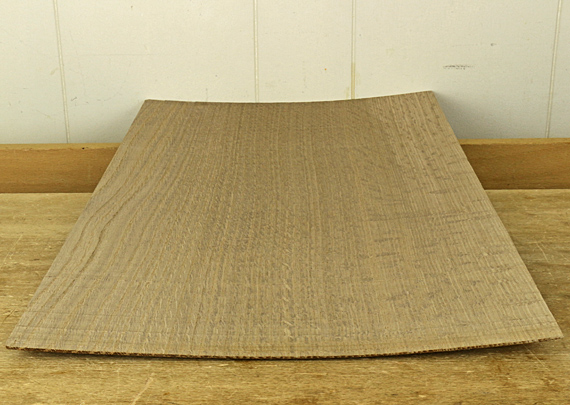
As much as we love wood, it can hit us with some awful surprises. Honeycomb, a drying defect, is among the worst. Here I will recount my sad tale of 8/4 quartersawn white oak, hoping you will be spared the same fate.
First, let’s briefly review a simplified version of the drying process.
The outer part of the board – the shell – loses it bound water and shrinks earlier than the inner part of the board – the core. The shell is in tension because it wants to get smaller but is limited by the still moist and swollen core, which is thus in compression. If this happens too fast, surface checks may result, which later may close and go unnoticed.
The shell sets in size. Now, as the core loses its moisture, it wants to shrink but is limited by the surrounding shell. Thus, the core is now in tension and the shell in compression, a condition known as case-hardening.
The kiln operator modifies the moisture content at the end of the drying process, and ideally, there would be no remaining stress. However, the irremediable state of reverse case-hardening must be avoided, so a bit of case-hardening is acceptable in the final state of most kiln-dried lumber, demonstrated by a slight inward curve of the tines of a test fork sawn from a cross-section sample of the board (below).

Note that this is not a matter of a moisture gradient across the thickness of the board; it is physical stress. If you resaw lumber, you’ve certainly encountered this.
But what if the core dries too fast? Hygroscopic wood movement is a powerful force, stronger than the wood itself. Therefore, the core of the wood, desperately trying to shrink within the restricting frame of the shell, simply breaks. Honeycomb! (top photo)
Worst of all, this is not visible from anywhere on the outside of the board. The only clue you might get, which is inconsistent at best, is to note the board is oddly concave across its width on both sides. The cracks, revealed only when you crosscut the board, occur perpendicular to the annual rings in both flatsawn and quartersawn lumber.
So, what happened in this white oak board? Probably several factors conspired. 8/4 is, of course, much slower to dry than 4/4, white oak is a relatively difficult species to dry well, and quartered lumber is a bit slower to dry. My guess is that this board was not sufficiently air dried before going to the kiln. Further, since 8/4 white oak is less common, this board was probably lumped together in the kiln with thinner lumber and/or faster drying species for which a faster kiln schedule would work. In other words, it was rushed to market.

What about using the parts of the board without honeycomb? Nope, best not. Even sections distant from the frank honeycomb were severely case hardened, as demonstrated by these test forks (above). Whether a lot or a little of the interior core was removed, the tines are bent over each other. It was amazing how forcefully they bent inward against each other before I halved their widths so they could cross over each other. Again, to be clear, there was no moisture content gradient across the thickness of the lumber.

Severe stress like this wreaks havoc in the building process. I tried to salvage the expensive board but as I would incrementally remove thickness, attempt to resaw, or shape the wood, it persistently distorted. I was constantly and futilely chasing true surfaces. Enough.
Woodworker, beware.


Rob,
Crazy white oak test forks. I’ve seen a few with minor curving, but those are terrible!
Any thoughts on recourse when such wood is purchased? I suppose it depends on where you bought it, but I think any woodworker who finds they’ve purchased such lumber should take said lumber and test forks back to the seller and request (politely demand) a refund for the incorrectly prepared lumber.
And again, I find myself quite happy to be using air dried walnut and white oak that my brother and I cut down and had milled by a neighbor. We air dry it all in the upper story of a 100 year old barn, which seems to have just enough air movement and coverage to provide an even drying rate.
That hurts.
The last I looked 8/4 WO, in my neighborhood, is going for more than $10 USD a BF. If the price of wood keeps going up, and it will, I may be forced into building shabby chic pallet wood furniture :-).
ken
Ethan,
Yea, pretty bad wood. I intentionally avoided the recourse issue but, of course, yup, I do see your point.
Ken,
I’m feeling that way too.
Rob
Excellent example and entry. I appreciate this explanation very much. Keep up the great work.
Thanks, David. May you be spared the dread honeycomb.
Rob